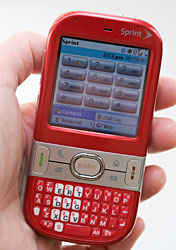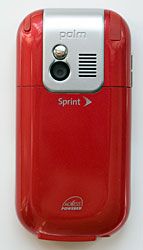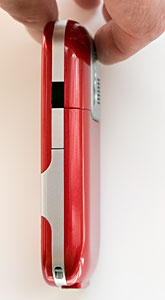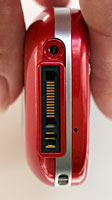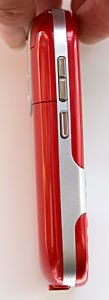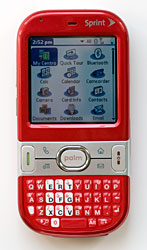
|
||||||||||
The keyboard's keys are tiny, and while they look unusable, we found it quite easy to type. Impressive work, Palm. A Treo it's not, but the keyboard is decent. It's easier to type with fingernails (even short ones) rather than blunt finger tips, and the keys have a soft plastic texture that prevents finger slips. The keys are backlit in white, and the number keys are reversed with a white background to make dialing easier. The usual Palm OS find, menu and backlight (option+p) keys are there, and the phone dialer, home, email and calendar buttons surround the small oval d-pad. Opinions were divided on the d-pad; some loved it while others found it too small to operate easily. The Centro feels great in the hand and is easy to operate one-handed, including the keyboard. Text message addicts will no doubt love the phone since it makes one-handed SMS-ing a breeze. Like the Treo, the device has call send and end buttons, but the call send button doesn't bring up the phone dialer screen. We still don't see the point in having two buttons, call send and phone dialer screen launcher, when one would do. The incredibly loud and clear speaker is on the back of the Centro, and it worked well for calls and Sprint TV video playback. The phone has a 2.5mm stereo headset jack on the bottom, but no headset is included. The standard Palm connector lives on the bottom edge, along with the charging port. Sprint includes a compact world charger and and adapter to use "Sprint approved" 1 amp chargers with the Centro.
Call quality is good on the Centro, and it gets a strong signal than the Treo 755p, Samsung UpStage and several other Sprint phones we've reviewed. Volume was high compared to Treo models and the phone is loud enough for somewhat noisy environments. The speakerphone is very loud and clear with no buzzing at moderately high volumes. The Centro works with Bluetooth headsets and like most Treo models, range isn't its strong point. We tested it with the Plantronics Explorer 330 and the Scala 700 both of which normally have good range with handsets (15 to 20 feet). We got about 8 feet with both headsets, but as a consolation both volume and sound quality were good. For data, the Centro has EV-DO rev. 0 (Sprint Power Vision) with fallback to 1xRTT. "Web", the ubiquitous Palm OS browser is back and it doesn't inspire us. But we're not the target users for the Centro, and we expect that novice smartphone users and those accustomed to basic WAP browsers will think highly of Web, whose real name is Blazer. It renders HTML sites decently, albeit without serious desktop fidelity, and Javascript, dHTML and other web standards aren't strongly supported. VersaMail (the icon labeled "email" is another Palm staple, and it handles POP3 and IMAP email. Versa mail is capable and reliable-- we have no qualms with it and it supports attachments. It supports MS Direct Push email with Exchange Server 2003 out of the box (no separate download or installation required). Sprint's email solution is also included, and that service is free for users who subscribe to a data plan. Sprint's Power Vision data plans for PDAs start at $25/month, and tethering (using the phone as a modem for a notebook) is $39.99/month.
Sprint includes an IM client that handles AIM, Yahoo and Windows Live Messenger. This apps uses both data and SMS, so a plan that includes data and a text message pack would be advisable if your a heavy IM-er. And for you streaming media addicts, the Centro comes with Sprint TV (powered by Kinoma). 50 channels, including complete TV episodes are there to make that bus or train ride entertaining. Channels include ABC, CNN, NBC, MTV, VH1, BRAVO and many, many more. We were impressed with video quality, which far exceeded Sprint TV offerings on feature phones. Video plays back in a relatively large window and it's sharp and clear. Video and audio stay in sync, but there's occasional digital garbling (blockiness). We found it more watchable than most mobile streaming media services, both in terms of video quality and programming. For non-streaming media, Palm includes the Pics & Videos application which handles image and video playback. The app is great for viewing photos, but video support (beyond video taken with the camera) is best left to 3rd party applications like The Core Pocket Media Player. The Centro's 312MHz XScale processor is up to the job of playing video loaded onto a card, and we found it managed 350kbps files fine. The 2.25" (according to our ruler, measured diagonally) display is bright, sharp and at 320 x 320 pixel resolution, is suited to mobile video playback. We wouldn't call this a top display among PDA phones but it's very good for a $99 model and isn't much different from the Treo's. The 1.3 megapixel camera won't wow you, but Palm did an excellent job with the image processing algorithm and gets very pleasing (though not accurate) colors and a natural sharpness in well lit scenes. There's lots of noise, even in well-lit shots, which surprised up in this day and age, and that renders the camera useless in dimly lit indoor situations. Photo resolutions are 1280 x 1024, 640 x 480 and 320 x 240. There are few settings available, and these are: effect, date stamp, shutter sound on/off and prompt sound and review period. You can save photos to a card and send them via Sprint PictureMail (MMS).
There are separate icons for camera and camcorder, though you can switch between the two modes once in the application. Video resolutions are 352 x 288 and 176 x 144, and you can record audio (or not), disable the shutter sound, use a limited palette of effects (normal, black & white, sepia) and save video to a card. Video colors are decent, but there's a great deal of motion blur and moderate noise. Once again, for a $99 PDA phone, we won't complain: the camera is decent for outdoor shots and colorizes in a pleasing fashion.
Battery life has been surprisingly good for a CDMA phone with EVDO. The Centro lasts as long as our Sprint Treo on a charge, and the Treo has a much larger battery. The folks at Palm must have worked a little power management magic here, because the phone lasted more than 2 days on a charge with moderate use that included 30 minutes of Sprint TV watching each day (streaming media over EVDO usually eats power fast). Palm and Sprint claim the Centro's 1150 mAh replaceable Lithium Ion battery is good for 3.5 hours of talk time, and in our tests that's right on the mark. Conclusion The Centro isn't a revolutionary, cutting edge device. But in its own way, it's starting a quiet revolution: this is the first touch screen PDA or smartphone to sell for only $99 at introduction. And it covers all the basics well: good phone quality, quality streaming media and MP3 playback support (once you get a hold of a stereo headset), the usual Palm ease of use, strong PIM apps to keep you organized and a QWERTY keyboard that's sure to please former feature phone users who are tired of T9. And we're happy to see Documents To Go 10 included with support for reading, editing and creating Word, Excel and PowerPoint documents. Power users will want to look at the Palm OS and Windows Mobile Treos or other competing power user smartphones, but for those who don't need everything but the kitchen sink, the Centro is worth a look. Price: $99 with a 2 year contract from Sprint Web sites: www.palm.com, www.sprint.com
| ||||||||||
